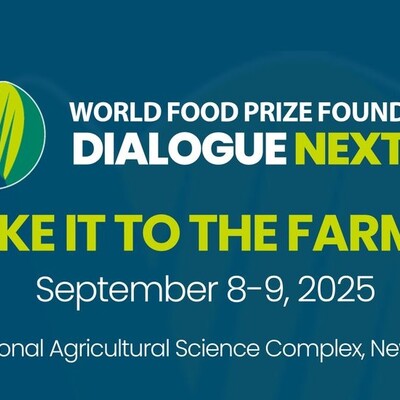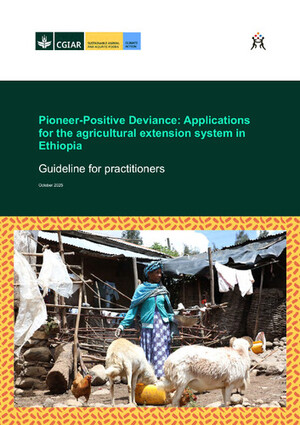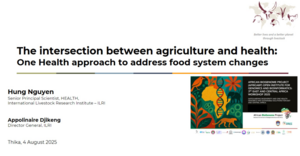
‘A vaccine is coming—the question is how soon’
Nobel Prize winner Peter Doherty addressed the International Livestock Research Institute (ILRI) at its latest Town Hall meeting
Nobel Prize winner in physiology or medicine and ILRI patron Peter Doherty discussed vaccines, herd immunity, and policy responses to COVID-19 with Director General Jimmy Smith at ILRI’s weekly digital town hall meeting on 29 May 2020. Doherty’s association with ILRI goes back to the 1990s, when he served as a board member overseeing the science program of one of ILRI’s predecessor institutes, the International Laboratory for Research on Animal Diseases (ILRAD). Doherty won the Nobel with Rolf Zinkernagel of Switzerland in 1996 for their discovery of how the body’s immune system distinguishes virus-infected cells from normal cells.
Doherty’s discussion was both scientifically detailed and cautiously optimistic. A vaccine is coming, he said—but the question is how soon. There are at least four candidates in development in England, the US and China, using a variety of methods, from a killed version of the virus (as was used in early versions of the polio vaccine) to a recombinant adenovirus method that involves grafting identifiable parts of the COVID-19 virus onto a live but weakened version of the virus that causes the common cold. The methods differ but the goal is the same: To induce the immune system to recognize and fight off the coronavirus before it overwhelms the body.

Peter Doherty, Nobel Laureate in Physiology or Medicine (1996) and former board member of ILRI’s predecessor, ILRAD, as sketched by the late ILRI immunologist Declan McKeever in the mid-1990s (illustration credit: ILRI/David Elsworth).
Ironically, one of the challenges to the development of a vaccine is that in many places public policy responses have pushed down the incidence of the disease, reducing the likelihood of exposure for those volunteering to test the vaccines. It is hard to measure how effective a vaccine is at preventing an illness if relatively few people come down with the disease to begin with. ‘We have to be careful’, said Doherty, ‘because this is a vaccine we’re going to put into large numbers of young people who aren’t suffering that much from the disease’. Nor is it clear how quickly we can ramp up production of a vaccine, once it’s shown to be effective. Such is the urgency of the situation that vaccine production is now overlapping with the testing. In India, for example, they are producing 16 million doses of one particular vaccine, in case it’s shown to be effective. The bottom line: ‘My personal opinion, from what I’ve been told, is that we’ll be unlikely to see large scale vaccination programs before early to mid-2021’.
On whether the vaccine will be distributed fairly to developing countries, Doherty was also cautiously optimistic. He noted that both the World Health Organization (WHO) and the Center for Epidemic Preparedness Initiative (CEPI) are determined there should be equity in vaccine distribution. The hurdles, he observed, were unlikely to be scientific or technological. ‘It gets into politics and all sorts of things’, he said. ‘We hope that we’ll see vaccines out there in the developing countries soon, but how that will play out in some of the advanced countries that are being very protective of their own interests and are not sharing all that much, we’ll have to see’.
He was more optimistic on the issue of immunity response. Accounts of people testing positive after initially testing negative by polymerase chain reaction (PCR) tests have led to speculation that the body may not produce an effective immunity response to the virus. But these tests, which are acutely sensitive, may simply reveal that bits of the virus linger in the body without any risk of causing new infections. ‘My suspicion is that people are going to be pretty immune. If they do get re-infected again in a year or two, I suspect it will be with a much milder infection. But we really don’t know the answers to that, because we’ve only had known about the virus, at least in Western countries for about four months’.
ILRI, said Doherty, has a vital role to play in combating the pandemic, in several ways. The first is in training outstanding young molecular and other scientists in Africa. ‘Simply training people [in laboratory work] is enormously important, and that’s a great contribution you can make’, he said. In addition, ILRI can work with the government of Kenya to assist it in public health. With its molecular expertise, it could become a testing lab for PCR diagnosis. In fact, as Smith mentioned, ILRI is doing precisely that: With German assistance for its One Health Centre, ILRI is providing its advanced bioscience laboratories and technical staff to support the Kenya government’s testing capacity for COVID-19.
On the One Health approach, which ILRI has long championed, Doherty said he was hopeful that the time had come to value it more highly. The medical side of public health has tended to be self-sufficient, he said, while the environment, veterinary and agricultural sectors have been comparatively neglected especially funding-wise. Given that we’ve had at least three serious zoonotic pandemics in the past twenty years, focusing on One Health is ‘certainly something to consider’.



















